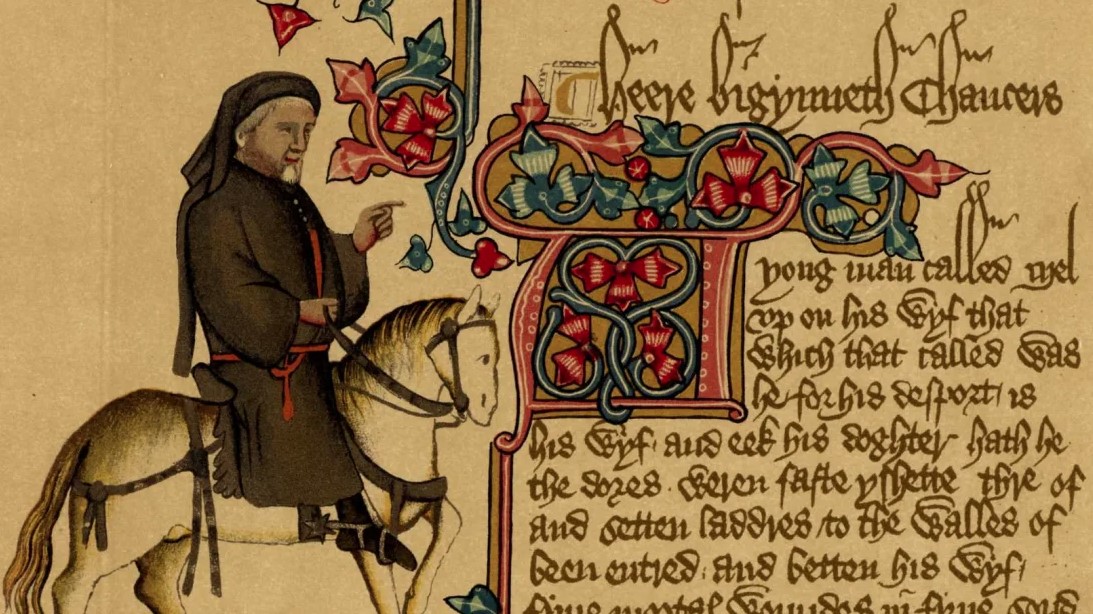Exploring Time and Space in Chaucer’s General Prologue

Attending the 2023 International Conference for the Study of Medievalism sparked my reflection on Chaucer’s General Prologue‘s exploration of time, space, and affect.
Geoffrey Chaucer’s timeless masterpiece, The Canterbury Tales, remains a seminal work in the canon of English literature. Within the General Prologue, Chaucer’s use of the terms “time” and “space” reveals profound insights into the medieval understanding of narrative construction and character development. This short blog post explores some of my thoughts on the intricate interplay between these concepts, shedding light on how Chaucer manipulates the spatial and temporal dimensions to evoke affective responses in his characters and readers.
The Spatial Dimensions: “Space of the Page”
At a surface level, Chaucer employs the term “space” to refer to the physical layout of the text on the page. In the General Prologue, this notion of space extends beyond mere textual arrangement; it encompasses the cognitive space within the reader’s mind. Chaucer, acutely aware of the limitations of the physical page, utilizes descriptive spatial elements to create vivid, tangible images of the characters. Through meticulous detailing, he constructs a spatial realm where characters come to life, transcending the confines of the parchment and resonating within the reader’s imagination.
For example, Chaucer’s description of the Prioress is rich in spatial imagery:
Ther was also a Nunne, a Prioresse, That of hir smylyng was ful simple and coy; Hir gretteste othe was but “By Seint Loy!” And she was cleped Madame Eglentyne.
The reader can easily visualize the Prioress’s gentle smile and demure demeanor, thanks to Chaucer’s meticulous use of spatial language. Chaucer also uses spatial imagery to convey the social hierarchies and power dynamics of medieval England. For example, the Pardoner is described as having a “leprous face” and a “pile of pardons hanged upon his chin,” suggesting his moral corruption and fraudulent practices. The spatial proximity of the pardons to his chin further reinforces his status as a religious peddler, hawking his wares to unsuspecting pilgrims.
Temporal Dimensions: The Fluidity of Time
Chaucer’s manipulation of time is equally nuanced. In the General Prologue, time is not a linear construct but a fluid entity, allowing characters to traverse between the past, present, and future. Characters’ narratives are not bound by chronological constraints, enabling Chaucer to weave a complex temporal tapestry that enriches the storytelling experience. This fluidity of time serves as a canvas upon which characters’ histories, aspirations, and conflicts are painted, enhancing the depth and complexity of their personalities.
For example, the Knight’s Tale is a chivalric romance set in ancient Greece. However, Chaucer’s description of the Knight’s physical appearance suggests that he is a contemporary figure:
A knyght ther was, and that a worthy man, That fro the tyme that he first began To riden out, he lovede chivalrye, Trouthe and honour, fredom and curtesye.
The Knight’s physical presence in the General Prologue, alongside the other contemporary pilgrims, blurs the boundaries between past and present, creating a sense of temporal fluidity. This fluidity of time allows Chaucer to explore timeless themes such as love, loss, and redemption through the lens of diverse historical periods.
Affective Space: Characters and Their Environments
While the medieval understanding of “affective space” as a distinct concept might be anachronistic, Chaucer undeniably imbues characters with emotional responses to their environments. Medieval literature often depicts characters profoundly influenced by the spaces they inhabit. Chaucer’s pilgrims, diverse in social status and background, react emotively to the spaces they find themselves in, reflecting the social hierarchies and power dynamics of medieval England. Through these affective responses, Chaucer adds layers of complexity to his characters, underscoring the symbiotic relationship between individuals and their spatial surroundings.
For example, the Wife of Bath’s relationship with the Church is complex and ambivalent. She is both a devout Christian and a shrewd businesswoman, and her conflicting emotions are reflected in her response to the physical space of the Canterbury Cathedral. On the one hand, she is awestruck by the cathedral’s beauty and grandeur, exclaiming:
Lordyngs, ther is in Paris a tournesse And eek a chambre, which men calle the Fame. I wolde ye wiste how that chambre is wrought: Thogh it be of timber and of glass, Yet it shyned as the sonne upon the lee.
On the other hand, she is also critical of the Church’s hypocrisy and corruption, suggesting that the cathedral’s physical beauty is a façade for moral decay. This ambivalent response to the cathedral reflects the Wife of Bath’s own complex and multifaceted character.
Conclusion
Chaucer’s exploration of “time and space” in the General Prologue transcends mere narrative technique; it is a testament to his profound understanding of human experience and his anticipation of later literary developments. While the medieval understanding of affective space might be anachronistic, Chaucer’s insights into the relationship between individuals and their spatial surroundings remain relevant today.
By exploring the intricate interplay between time, space, and affect, Chaucer crafts a timeless exploration of the human condition. His characters are not simply confined to the pages of the General Prologue; they exist in our minds and hearts, inextricably linked to the spaces they inhabit.
Chaucer’s exploration of affective space anticipates later literary developments, such as the rise of psychological realism and the modernist emphasis on the subjective experience. His insights into the relationship between individuals and their spatial surroundings continue to resonate with readers today, as we grapple with the complex and ever-changing world around us.
Leave a Reply